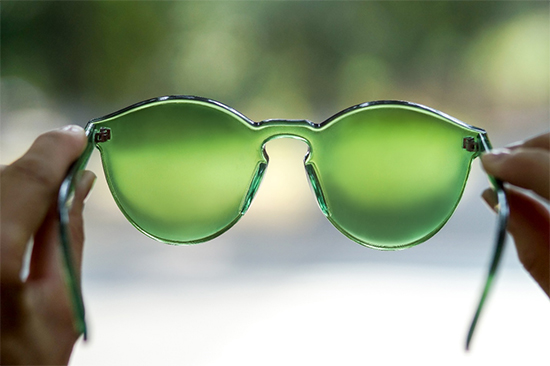Green has a fascinating history in the optical world. For as long as there’s been even a vague concept of optics, green has been known for its relaxing qualities, and some of the earliest records we have of “sunglasses” refer to green lenses. In his work Natural History, Pliny the Elder described how the Roman Emperor Nero would watch gladiator matches through an emerald. However, it isn’t known whether the emperor used green stones to enhance acuity or as a shield from sunlight. An article from the ZEISS website notes that “green has been scientifically proven to have a calming, generally positive effect on the body and mind.” And the VSP Sunglass Lens Color Guide states, “Sunglasses with green lenses provide better contrast than gray lenses and transmit color accuracy better than brown lenses. Ideal for both sunny and low-light environments, green lenses have a way of reducing glare while brightening shadows.”
In the early 1920s, movie stars began to be seen wearing sunglasses, and in 1929, Sam Foster introduced his inexpensive, mass-produced sunglasses on the Atlantic City Boardwalk. Green doesn’t seem to have waned in popularity until the mid-20th century, when it was usurped by today’s standbys: Grey, brown, and G-15. Of course, grey lacks the color distortion of true green; brown enhances contrast; and G-15 combines green’s relaxing qualities with the neutrality of standard grey. So long, true green, eh?
 |
I first became aware of a resurgence in interest in true green lenses through the vintage clothing enthusiast community that began emerging out of the early 21st century and became a real force in the fashion world after the success of period shows such as Mad Men, Boardwalk Empire, and, to an extent, Downton Abbey, made wearing old clothes a fashion statement rather than an eccentricity. Browsing message boards related to both vintage and contemporary fashion, whenever the subject of vintage sunglasses came up, inevitably someone would ask: Where can I get bottle green lenses? It seemed that when someone asked for “bottle green” they got G-15 instead; and when someone gave the name of a doctor (or even website) that could provide the correct shade, there was a mad rush.
I decided to take the plunge myself to see if the usefulness of green lenses translated to the modern world. I was pleasantly surprised to find that, while no G-15, when worn indoors, true green is quite relaxing while maintaining good visibility. Unlike blue, green provides a lush, soothing experience. It also works well as a stopgap measure when moving between low light and bright environments. While some fashion-only tints can strain people’s eyes outdoors, green provides some relief against bright light, and when tinted a #3 rather than #2, is somewhat comparable to amber or G-15 in terms of contrast, eye relaxation and color distortion. For the image conscious patient, green also goes well with a wide variety of frame colors, in particular, gold, black zyls, and best of all, tortoiseshell, for that true vintage look.
Green certainly isn’t a tint for everyone. As younger patients become more of an economic force, though, and seek to diversify their wardrobes, it’s an excellent color with which to differentiate your dispensary while also providing your patient a unique and satisfying eyewear experience.
Welcome back, true green. We missed you.
Note: Be sure to provide lenses that have 100% UV protection, regardless of color.
Lenses used in research for this article were provided by Glass Optical, Dallas, TX













